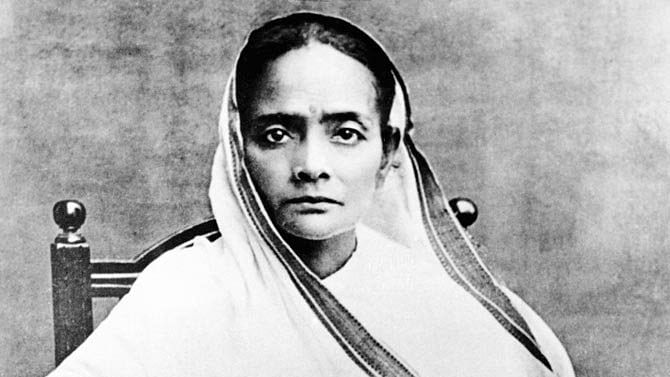New Delhi: Kasturba Gandhi’s life was too far entrenched in her husband’s — Mohandas Karamchand Gandhi — to pry apart. Born on 11 April 1869 as Kastur Kapadia, little is known of her life before her marriage. But the glimpses available paint the portrait of a woman of exceeding patience with an unwavering will.
Her silence in the face of Gandhi’s magnanimity is often read as submission, or absolute devotion, to her husband. That very well may have been the case — she was, after all, steadfastly by his side no matter what.
But Kastur, as she was known before her marriage, was by no means a passive follower of her husband’s will. As her grandson Arun Gandhi tells us in his biography Kasturba: A Life, Gandhi drew from his wife the substance of a movement that grew much bigger than both of them.
On satyagraha, Gandhi’s famous doctrine of non-violence, Arun wrote, “My grandfather’s own writings yield implicit evidence of his dependence of his wife and his intimations of his identification with her. He repeatedly testified, for example, that his basic philosophy of nonviolence was simply a reflection of the basic qualities of Kasturba’s character — ‘an extension of the rule of satyagraha she practised in her own person’.”
As often happens with women, Kasturba’s role in the freedom struggle and her influence over Gandhi’s life has been relegated to the shadows. But without her “unfailing cooperation”, Gandhi himself once admitted, “I might have been in the abyss.”
Also read: The two family members of Mahatma Gandhi who dared to disagree with him
A true companion
Kastur Kapadia was born to a relatively wealthy family in Porbandar, Gujarat, and was married to Gandhi in 1883. The couple was born months apart, and she was 14 when they got married and Gandhi 13.
As they fumbled about, discovering adulthood and married life, Gandhi began to develop — with the help of a pamphlet explaining the traits of a ‘good’ husband, his grandson informs — a liking for control that he never truly shed.
At the beginning of their relationship, this need to exercise control is said to have manifested itself in fits of jealousy. Although a child himself, he imposed upon her unreasonable restrictions, asking her to seek his permission every time she wanted to step out of the house.
As was customary at the time, she followed his mother, with whom they were then living, to the temple, only to be later censured by Gandhi, who was upset she disobeyed his orders.
Young Kastur decided she would have none of it, and silenced him with a question: “Are you suggesting that I should obey you and not your mother” she asked, as recalled in their grandson’s biography.
This obstinacy, one Gandhi regarded grudgingly for much of his life, kept Kasturba grounded in their tumultuous relationship. Gandhi’s many, fast-changing avatars — from an impatient, jealous adolescent to ‘the mahatma’, and from a “lusty” young man to a celibate one by the time he was in his mid-30s — made it clear to Kasturba that she had to catch up.
Often, she did so without complaint, but always taking her time. She was slow to accept caste equality, for example.
Interestingly, Gandhi’s decision to adopt celibacy in 1906 was a decision she didn’t oppose — at least according to Gandhi. He recounted her acceptance plainly in his autobiography The Story of my Experiments with Truth: “She had no objection”.
Also read: This leader forced Mahatma Gandhi to change his views on caste
Freedom struggle
Kasturba was first arrested in 1913 in Durban for protesting against the Cape Supreme Court’s decision to declare the marriages from religions permitting polygamy — including Hinduism — to be null and void (polygamy in Hinduism was only outlawed in India in 1955).
Despite her husband’s dissuasion, which included telling her that her participation would be disgraceful if it weakened her health, “Mrs Gandhi was not to be moved”, wrote Indian Opinion, a newsletter founded by Gandhi, in 1913.
She participated, and it wrecked her health too, but nothing stopped her from dedicating herself to satyagraha.
She was arrested three more times upon returning to India, including in 1939, when the women of Rajkot asked her to protest with them against British rule. It earned her a month of solitary confinement.
“She had great courage, both physical and moral, as can be seen from the grave illnesses she suffered and overcame, the hardships of her early days in South Africa and during her imprisonments,” historian Aparna Basu wrote in her biography of Kasturba Gandhi (titled Kasturba Gandhi). “In fact she was a source of strength to her fellow women prisoners.”
After having moved back to India in 1915, Kasturba’s gentle persuasion touched the lives of many women, and she proved herself to be a crucial tool in furthering the movement.
If Gandhi beckoned women to join the movement, it was Kasturba who gave them conviction. While Gandhi was in jail, she made a speech as part of the Quit India movement on 9 August 1942, saying, “The women of India have to prove their mettle. They should all join in this struggle, regardless of caste or creed. Truth and nonviolence must be our watchwords.”
Her final spell of jail time came in 1943, when she was 74. Her health quickly deteriorated, and she suffered two heart attacks over the course of one week.
She finally passed away on 22 February of 1944, three years before the Independence she ardently fought for and four years before her husband was shot dead at a prayer meet in Delhi.
Also read: Mahatma Gandhi’s second son Manilal was an obedient man with suppressed dreams




Behind every successful man is his feisty woman, who, unfortunately is never resurrected with a statue on a pedestal.